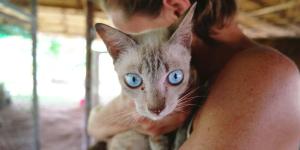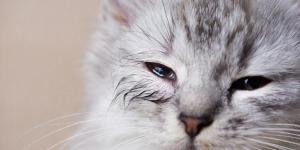My Cat Has a Pussy Eye - What to do



See files for Cats
Eye discharge is often a clear sign that something is wrong, and while it might be tempting to wait and see if it resolves on its own, addressing the issue promptly is crucial. Various underlying factors—ranging from infections and allergies to more serious health conditions—could be causing this symptom. Identifying the root cause early can help prevent complications and ensure your cat gets the right treatment.
In this AnimalWisesd article, we’ll explore the common causes ad treatments of eye discharge in cats, what you should do if you notice it, and when it’s time to seek veterinary care to ensure your feline friend’s eyes stay healthy.
Common eye conditions
When a cat develops discharge in one eye that persists, it’s natural for owners to worry about an underlying eye condition, and this concern is valid. There are several common eye diseases in cats that can cause increased tear production and discharge. Typically, these conditions lead to inflammation and irritation of the eye, triggering an increase in tear production as part of the body's defense mechanism.
If the tears are mixed with mucus or become thick, they can accumulate in the tear duct area, drying out and forming yellowish or greenish discharge. This is especially noticeable if the discharge is allowed to dry around the eye.
Some of the most common eye conditions that cause discharge in one or both eyes in cats include:
- Keratitis (inflammation of the cornea)
- Conjunctivitis (inflammation of the conjunctiva)
- Uveitis (inflammation of the uvea)
- Glaucoma (increased pressure within the eye)
- Corneal ulcers (damage to the cornea)
What Should You Do?
Each of these conditions can have various underlying causes. For example, conjunctivitis is a frequent issue in cats and can be caused by infections, allergies, or irritants.
If you notice excessive eye discharge, along with redness, swelling, or signs of discomfort such as squinting or rubbing at the eye, it's essential to visit a veterinarian. The vet will perform diagnostic tests to determine the cause of the problem.
Treatment will depend on the specific diagnosis:
- In many cases, the vet may prescribe eye drops or ointments to treat infections, reduce inflammation, or manage pain.
- For conditions like glaucoma or severe corneal ulcers, surgery might be necessary.
- If the cause is a bacterial or viral infection, antibiotics or antiviral medication may be required.
In any case, prompt veterinary attention is crucial to prevent worsening of the condition and preserve your cat’s vision.
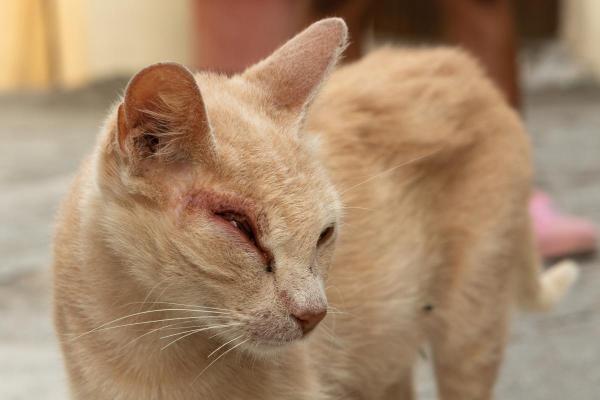
Foreign objects
One of the most common reasons a cat may develop excessive eye discharge in one eye is the presence of a foreign body. Cats are naturally curious and playful, and this exploratory behavior can sometimes lead to problems, especially for outdoor cats.
Small objects such as stones, branches, thorns, or other debris can accidentally enter the cat’s eye, lodging in areas like the eyelid or tear duct conjunctiva. These foreign objects often go unnoticed initially but can cause significant discomfort.
In such cases, it’s common to observe that the cat is rubbing its face against objects or repeatedly pawing at the affected eye. As a result, the eye may become red and watery. The increased tear production is the body’s natural defense mechanism. However, as the tears mix with dirt, fur, and dead cells, they can dry and form thick, mucous-like discharge.
What Should You Do?
If you notice a foreign body in your cat's eye, and it is easily accessible, you can carefully remove it and then rinse the eye with saline solution to clean out any remaining dirt or debris. However, if you are unable to remove it or if the foreign object is embedded too deeply, it is important to take your cat to the veterinarian for proper care. The vet will be able to safely remove the object and treat any resulting irritation or infection.
Infections
Eye infections caused by microorganisms are a common cause of discharge in cats, affecting one or both eyes. Viruses, bacteria, fungi, and even parasites can lead to inflammation in the eye.
In more severe cases, these microorganisms can cause dangerous systemic diseases, impacting not only the eyes but also other organs in the body. The primary infectious causes include:
- Feline rhinotracheitis: caused by feline herpesvirus type 1, this infection leads to eye discharge, eye ulcers, and greenish discharge. Cats with this condition also experience high fever and nasal discharge.
- Feline calicivirus: a potentially serious infection that causes conjunctivitis and eye discharge, in addition to affecting the upper respiratory tract and causing painful ulcers in the mouth.
- Chlamydiosis: caused by a bacterium, this condition results in persistent conjunctivitis and thick, purulent (pus-like) discharge.
- Aspergillosis: although less common, this fungal infection can affect the eyes, leading to conjunctivitis, keratitis, uveitis, and the appearance of eye discharge.
If the discharge from your cat’s eye is dark brown or black, parasitic infestations such as fleas, mites, or ticks may be responsible. Their droppings can mix with dirt and tears, forming hard, crusty discharge that sticks to the skin and fur around the eyes.
What Should You Do?
In any case, it is crucial to seek veterinary care, as these infections require urgent treatment. The vet will diagnose the underlying cause and prescribe appropriate medications, which may include antibiotics, antivirals, or antifungals, depending on the condition. Did you know that certain home remedies can actually worsen cat eye infections? Learn the truth in our guide on treatments for eye infections in cats.
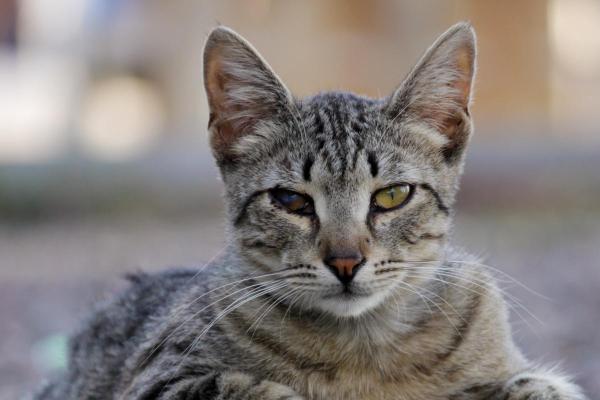
Injury or trauma
The delicate tissues surrounding the eye (the periocular area) are susceptible to injuries. Even minor impacts can lead to significant complications, such as the rupture of small blood vessels or damage to the tear duct.
These injuries often result in inflammation and increased fluid buildup in the area. When this fluid solidifies, it can lead to eye discharge, which may sometimes appear reddish if there has been bleeding due to a hemorrhage.
Periocular injuries can lead to serious complications if left untreated. Increased pressure within the eye (glaucoma) can damage the optic nerve, potentially leading to blindness. A cloudy lens (cataracts) can impair vision, making it difficult for your cat to see clearly. In severe cases, the retina, the light-sensitive layer at the back of the eye, may become detached, causing significant vision loss or even blindness.
What Should You Do?
Even if there’s no immediate eye discharge, internal injuries could still be present. It’s essential to take your cat to the vet for an examination to assess the extent of the damage and ensure proper treatment. Early diagnosis and treatment can significantly improve the chances of a full recovery.
Worried about your cat's red eyes? Learn what might be causing them and what you can do.
Eyelid disorders
There are two eyelid-related conditions that can lead to eye discharge in only one of a cat's eyes:
Entropion:
This occurs when one or both eyelids fold inward, causing the eyelashes, skin, and hair to rub against the eye. It can affect one or both eyes and is not only uncomfortable for the cat but also leads to symptoms like constant tearing, eye discharge, irritation, inflammation, itching, and excessive blinking. In severe cases, if left untreated, entropion can cause corneal damage, leading to ulcers and impaired vision. Surgical intervention is the definitive treatment.
Blepharitis:
This condition involves inflammation of the eyelids in one or both eyes, typically caused by viral or bacterial infections, parasites, allergies, trauma, or autoimmune diseases. Symptoms include eye discharge, crusting or peeling of the eyelids, and hair loss around the eye. The third eyelid often becomes inflamed and visibly exposed.
Both conditions can cause significant discomfort and may require veterinary treatment to avoid long-term damage.
Did you know that a swollen eyelid could be a sign of a serious underlying health issue? Find out more in our other article.
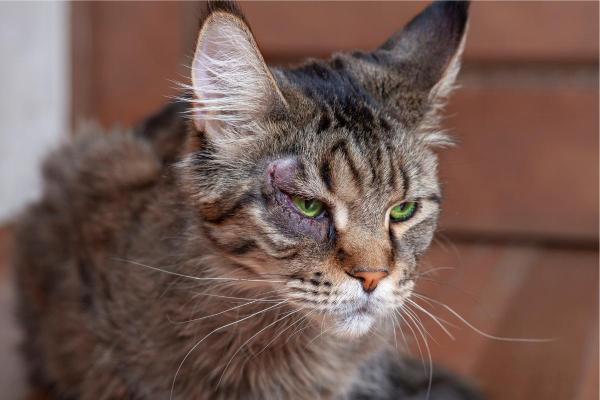
Environmental allergies
While environmental allergies are less common in cats compared to dogs, they can still occur and frequently result in allergic conjunctivitis. This condition leads to increased tear production, eye irritation, and, consequently, the appearance of eye discharge. Allergic conjunctivitis often presents with wet, red, and irritated eyes, and the cat may repeatedly rub or paw at its face due to discomfort.
Although allergic conjunctivitis usually affects both eyes, it is possible for only one eye to be involved, making the difference between the two noticeable.
What Should You Do?
Determining the specific allergen causing your cat's discomfort is crucial, especially for breeds like Siamese, Balinese, Oriental, Sphynx, Devon Rex, and Bengal, which are genetically predisposed to allergies. These breeds may be more sensitive to common allergens like pollen, mold, dust mites, and household chemicals.
To effectively manage your cat's allergies, consider treatment options such as medications, environmental changes, dietary adjustments, eye care, and in some cases, immunotherapy.
Brachycephalic breeds
Cats with brachycephalic features, like the Persian, are particularly prone to eye discharge, even in the absence of infections or eye diseases. These breeds have a distinctive facial structure characterized by a short, flattened snout and large, prominent eyes. This anatomy affects the normal functioning of their tear ducts, which can become easily blocked, leading to excessive tear production.
Their bulging eyes also dry out quickly due to increased exposure to air, causing a buildup of tears mixed with dead skin cells, hair, and dirt. This combination leads to the formation of crusty, dry discharge that adheres strongly to the corners of the eyes and the folds near the nose.
What Should You Do?
For brachycephalic breeds, maintaining good eye hygiene is essential to prevent complications. Here are some steps to follow:
- Daily cleaning: use sterile gauze soaked in saline solution to gently wipe away the accumulated discharge from the corners of the eyes and surrounding area.
- Moisturizing: in some cases, your veterinarian may recommend eye drops or artificial tears to help keep the eyes moist and prevent excessive dryness.
- Regular veterinary checkups: it's important to consult your vet regularly for advice on managing eye care in these breeds. Your vet will advise how often to clean the eyes and whether moisturizing treatments are necessary.
Want to keep your cat's eyes healthy and free from irritation? Discover the best cleaning techniques in our other article.
This article is purely informative. AnimalWised does not have the authority to prescribe any veterinary treatment or create a diagnosis. We invite you to take your pet to the veterinarian if they are suffering from any condition or pain.
If you want to read similar articles to My Cat Has a Pussy Eye - What to do, we recommend you visit our Eye problems category.


